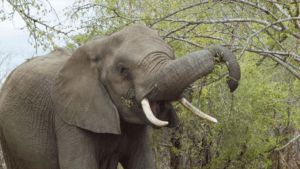As described in this article by The Years Project, Dr. Stephen Blake is a biology professor who studies the ways in which animals, specifically African elephants and tamarin monkeys, work to protect the planet from climate change. Referring to them as “gardeners of the forest”, he explains that elephants disperse a hundred or so different seed species over large distances as they forage. In turn, this helps create new trees that can further soak up increasing carbon levels. Furthermore, elephants have changed their diet by avoiding the slower-growing trees that are loaded up with carbon (as it otherwise would be released into the atmosphere).
Most humans, on the other hand, refuse to change their diet to a more Earth-friendly option. According to Business Insider, the meat industry accounts for “18% of human-produced greenhouse gas emissions”. For every single American that eats meat, a whopping 3.5 kg of carbon-emissions is released into the atmosphere per day. To produce meat substitutes, the carbon-emission cost is only 0.6 kg per person, per day.
I am perpetually stunned at the choices we make as a species. We would rather live in complete ignorance and denial than recognize the individual dietary changes we need to make in order to save this planet, and yet the elephant, a species that is literally being hunted into extinction by the minute, is willing to do so themselves. I have made the choice to go vegan, and yeah it was difficult. But it was an incredibly necessary one. I chose to be both selfless for the animals, the environment, the workers, and the world, but by doing so I am also being selfish — without the world, there is no me.
Even the tiny, 10-inch long tamarin monkey is doing it’s part to protect and nurture trees and the environment. Their feces contain undigested seeds that effectively plants trees within desolate, abandoned pastures originally cleared by humans throughout the Peruvian rainforest. Unfortunately, climate change is likely disrupting this natural seed dispersal, as it may be negatively impacting the growth cycle of the plants that tamarins eat. While not critically endangered as of yet, they also face the serious threat of deforestation and are sometimes hunted and captured as pets. Elephants have it even worse. According to the video accompanying this article, they have experienced a dramatic decrease in their population over the past century — from 10 million in 1930 to 350,000 in 2016. This is mostly due to poaching, but also to long-lasting, increasingly-common droughts brought about by climate-change.
We cannot rely on tamarins or elephants to fix the problems we caused, especially if they are in very real danger themselves — but we can learn from them. It’s time for us to take accountability and do whatever we can to help our dying planet, even if that means exchanging a bacon cheeseburger for an Impossible patty.



